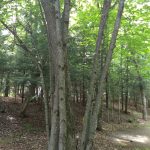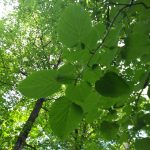Nature Trail
Kemp Station has a nature trail that runs about 1 mile long. It is rugged — often narrow, with exposed roots and stones, and some steep sections.
The trail begins at the Outdoor Pavilion and you may choose to follow along with the numbered stops.
- Outdoor Pavilion: Welcome to Kemp Station! Stop #1 on our walk is the Pavilion & Welcome Center. This building was originally a carport used by the Kemp Family. Now it is used as a place for groups to gather and for visitors to get oriented to the property. As you continue on this hike, you will learn about some of the unique features of the Kemp Forest.
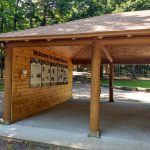
- Bat boxes: Wisconsin is home to 8 species of bats. Bats roost during the day and forage at night, eating thousands of insects. Kemp’s bat houses provides safe roosting and convenient access to water and food.
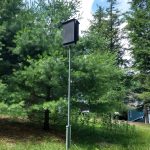
- Leatherwood: Leatherwood is a woody shrub common at Kemp. The wood of leatherwood is quite brittle but its bark it tough and flexible, like leather. It blooms early in spring, with yellow flowers. Watch for more leatherwood as you continue on your hike.
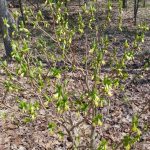
- Tip-Ups: In August 2000 a wind-shear significantly altered the forest at Kemp. Many trees were broken off or blown down, resulting in “tip ups.” As you continue your hike, you will notice many trees lying on their sides, with roots exposed and a hole where the roots once were. The term “tip up” refers to the roots that have been tipped up.

- Sunlight & the Forest: What effect does sunlight have on and in the forest? Prior to the storm of 2000, the forest floor received little light, so there was little or no ground cover. But trees fell during the storm creating gaps in the forest canopy. Sunlight enters through these gaps, allowing plants to grow once again on the forest floor. Can you see the differences in ground cover as you look through the forest? And look! – more “tip ups!”

- Big Woodpecker! Wisconsin’s largest woodpecker, the pileated woodpecker, is found at Kemp. If you don’t see one “live and in person,” you may hear it’s loud “kak-kak-kak” call or at least see the results of its search for insects, as evidenced in this tree snag. Watch for more evidence of woodpeckers as you continue your walk.
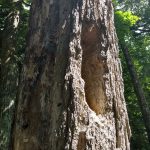
- Ferns & Club-Mosses: Two more common features of Kemp’s old-growth, hemlock-hardwood forest are ferns and club-mosses. Ferns thrive in shady, cool, damp areas. You will see several ferns on your hike, including Cinnamon Fern, Interrupted Fern, Oak Fern, Long Beech Fern and Maidenhair Fern. Club-mosses, or Lycopodium, are long-living evergreen plants whose main stem creeps over the soil surface and gives rise to many upright branches. Three species of Lycopodium found here are commonly known as ground pine, shining club-moss and stiff club-moss. You may see small cone like structures on the ground pine – these are strobili and are what produces spores from which club-mosses reproduce.
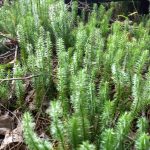
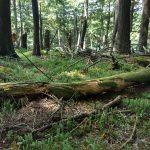
- Yellow Birch: See trees growing on the tip up? These are yellow birch saplings. Yellow birch seeds need exposed soil like that created by this tip up to germinate and grow. Keep an eye out for more yellow birch seedlings in the forest.
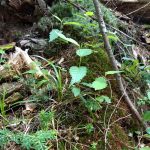
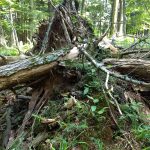
- Along the Water: There’s a lot to take in here and along the stretch of trail just ahead. First, check the water’s edge for marsh milkweed and it’s pretty pink flowers. You may see water birds, such as ducks or an eagle or osprey flying over this bay in search of a fish. If you’re really lucky, you’ll see an osprey dive into the water after a fish. Next, notice the evidence of beavers felling trees. Beavers use the fallen trees both for food and for building their lodge and dams. Finally, watch for turtles sitting on logs in the water or a frog’s eyes just above the water’s surface. You may also hear the banjo string “plunk” of the green frog!
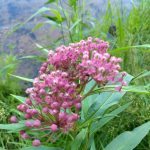
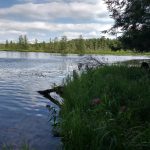
- Stairs to the Exclosure: Take these steps and follow the path to a deer exclosure. In 2001 ten of these exclosures were established on Kemp property to study the impact of deer browse on vegetation. This particular exclosure is quite dramatic, showing the growth of trees and other plants that were protected from hungry deer. Take the steps back to the main trail to continue the nature hike.
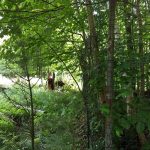
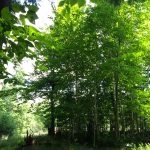
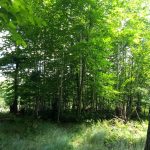
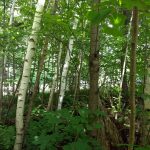
- Behind the Blowdown: Here you will notice a lot of open sky. You are next to the “Blowdown,” a 5-acre patch of forest flattened by the 2000 storm. Again the impact of light can be seen with the small hemlocks growing here at the edge of the trail. Hemlock is the predominant conifer in this forest and you can recognize the saplings by the droop of the leading branch. Compare that to a balsam fir sapling and the leading branch is pointing straight to the sky. The hemlocks at Kemp may not be giants but they are nearly 300 years old.

- Bat Monitoring Station: Kemp is one of several sites in Wisconsin that hosts a bat monitoring station. Powered by the sun, special equipment records the echolocation signals emitted by bats flying in the area. Each month we upload the data to bat ecologists with the Wisconsin Department of Natural Resources. The data tell them the species of bats flying at Kemp (each species produces a different echolocation pattern) and how many. Over time, researchers can see if the overall population of bats at Kemp is changing and they can monitor migration patterns. Data collection began in 2007.
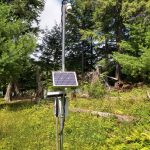
- Follow the Deer Path: From here to the road, you will be walking on a well-established deer trail. The nature trail once led through the dark hemlock forest to the road, but that leg is now buried beneath the tangle of the Blowdown. Instead, enjoy the view to your left, where you will see a bog lake we refer to as “The Inkpot.”
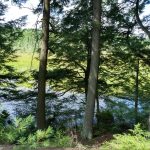
- Jyme Lake: Follow the grassy path to Jyme Lake, a small bog typical of northern Wisconsin. Follow the boardwalk to get a closer look. The floating mat of vegetation surrounding the open water is comprised of sedges, sphagnum mosses and unique bog plants like the pitcher plant and sundew. Walking on a bog is like walking on a waterbed. Watch for leopard frogs, dragonflies and damselflies. (Jyme is pronounced “jimmy”)
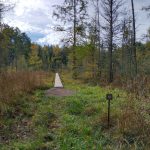
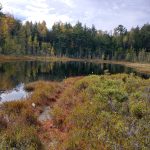
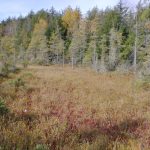
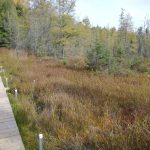
- The Blowdown: The blowdown is a unique feature at Kemp. Created during a storm in 2000, notice the obvious break in the once continuous hemlock forest. This natural opening is a wellspring of diversity – tree snags provide wildlife cavities and insects for food; a wide variety of plants and trees, including elderberry and raspberries, attract birds and mammals.
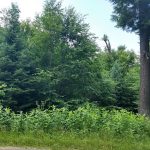
- Coarse Woody Debris: As you return to the forest, make note of the branches and logs that lay about on the forest floor. This is referred to as “coarse woody debris” or CWD. Nutrients in the wood are recycled and the CWD provides food and nutrients for a wide range of organisms, from mushrooms to salamanders to flying squirrels.

- Yellow Birch & Lichen: Take time to admire this grand old yellow birch. It is about 150 years old. According to the Wisconsin DNR’s forest data report in 2019, “The volume of yellow birch has increased 23% since 1983 but remained largely unchanged in the last two decades. The number of sawtimber trees has increased since 2004 but the number of saplings and poles has decreased..
Notice the light blue-green organisms growin on the bark; they are lichens.”Lichens are a complex life form that is a symbiotic partnership of two separate organisms, a fungus and an alga. The dominant partner is the fungus, which gives the lichen the majority of its characteristics, from its thallus shape to its fruiting bodies.” (USFS)
As you continue along the trail, notice that you are now walking on the back side of Jyme Lake.
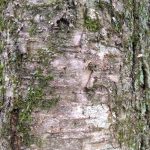
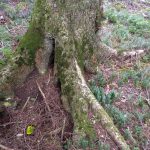
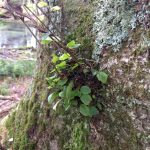
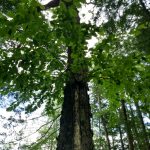
- Lightning Strikes: Lightning is another powerful force of nature. Notice the spiral scar on this tree, the charred wood from the heat, and the shattered pieces of tree lying about. What looks like destruction is actually creation – such strikes create cavities for birds and mammals, open the forest floor to more sunlight for new plants to grow, or cause forest fires, a natural disturbance that re-starts forest succession, where one temporary plant community is replaced by another, and then another, over time. For example, grasses and forbs are replaced by shrubs and seedlings, and eventually those are replaced by sapling and pole trees, and so on until it is a mature forest.
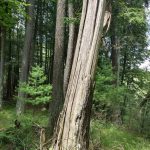
- The Green Room: “The Green Room” was given its name by botanist, Libby Zimmerman, who has been visiting Kemp for many years. She discovered this small kettle hole in the forest, filled with sphagnum moss. Imagine a giant block of ice sitting here 15 thousand years ago…that’s how the kettle formed. The ice broke off the retreating glacier and was buried by glacial outwash – soil, stones, etc. When the ice melts, a depression in the landscape remains.
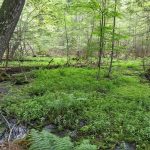
- Topography: Note the topography of the forest floor.
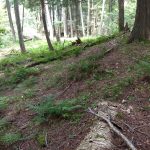
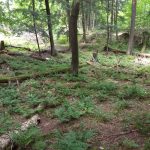
- Successional Plants: When trees come down in a forest, gaps are created in the tree canopy that lets in the sunlight. Seeds that have been in the soil for many years respond to the sunlight and grow. The wild raspberry is a pioneer or early successional plant. It thrives after a disturbance, like the wind storm at Kemp Station. Raspberry seeds can persist in the soil for decades, deposited there by birds and animals that ate them long ago. When conditions are right, the seeds germinate and soon we eat!
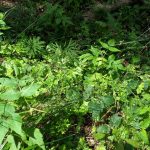
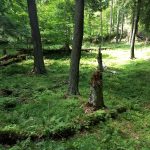
- A Hollow Log: Does a hollow log have a story? You bet! Imagine a small, slow-moving surface fire making its way through the forest, scarring trees in its path. Later, fungus moves in where the tree was injured by the fire, making the tree weaker in spots. The tree is blown down in a storm leaving a hollowed out log on the forest floor. Take a look inside….who put the cones in there?
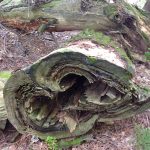
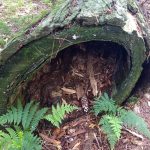
- Tomahawk Lake: From this point you have a nice view of Tomahawk Lake. It is 3,462 acres in size and is part of the Minocqua chain. It is an oligotrophic lake, meaning it is nutrient poor and the water is clear. Northern Wisconsin has one of the highest concentrations of freshwater lakes in the world!
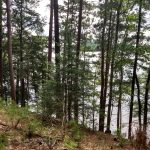
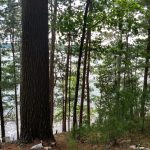
- Fire Scars: The fire story continues … can you find the fire scar at the base of this tree? The scar forms on the opposite side of the tree from where the fire started. Try to find other fire scars on nearby trees.
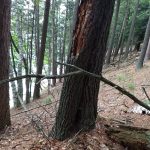
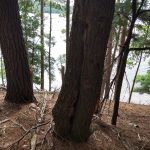
- Brown Rot: Notice the cubical shape of the decaying wood on this old tree. This is what’s known as brown-rot. A particular brown-rot fungi is at work here, breaking down the cellulose in the wood’s structure. During this process, the wood shrinks, turns brown and cracks into cubical shapes.
One brown-rot fungi is Laetiporus sulphureus, commonly known as sulphur polypore, sulphur shelf, and chicken-of-the-woods.
- Long-term vegetation plot: This is one of several long-term vegetation plots located on Kemp property. It was established in 1979 by UW-Madison botany faculty member, James Zimmerman (“Jim Zim”), to monitor the dynamics of forest understory plants. Such long-term research is critical to improving our understanding of how forests change and grow.
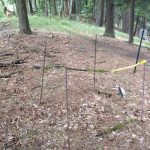
- Choose a Path: At this point, you can decide to take one of two routes. If you take the more difficult trail to the left, you will walk a narrow ridge along the lakeshore where you may see otter scat and harebells in bloom. Or take the easier trail to the right. Either way, you will pass a small sedge meadow that lies between the easy trail and the lake. Bluejoint grass is one of the predominant plant species in this sedge meadow.
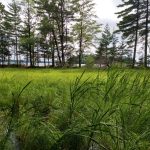
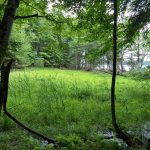
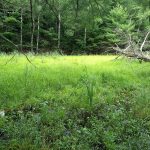
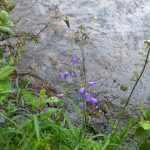
- Another Deer Exclosure: One more deer exclosure before leaving the forest. The white pines outside the exclosure have been browsed by deer, while the trees inside the fencing, especially the hemlock, are thriving.
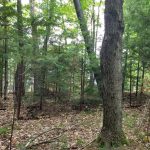
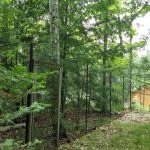
- Young trees: After the Mead Residence Hall was constructed, this area was newly exposed to more sun. For a few years, trilliums grew here, a plant not seen at Kemp for a couple decades. Today we find young conifers — balsam fir and white pine — in this spot, again, taking advantage of the sunlight.
The age of a conifer can be estimated by counting the number of “whorls.” A whorl is where multiple branches grow out from the main stem. Each year of growth on the main stem ends with a new whorl. You will notice that the length of the main stem between whorls varies from year to year, as various factors will affect each year’s growth. See if you can estimate the age of the young conifers at this stop.
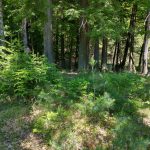
- Basswood: This basswood tree is our last stop before returning to the Pavilion. Notice the multiple trunks, which is characteristic of this fast-growing tree. Fragrant flowers in the spring attract bees. If you look around, you may find the pea-sized fruit of the tree, which falls to the ground attached to a lacy, wing-like leaf.
